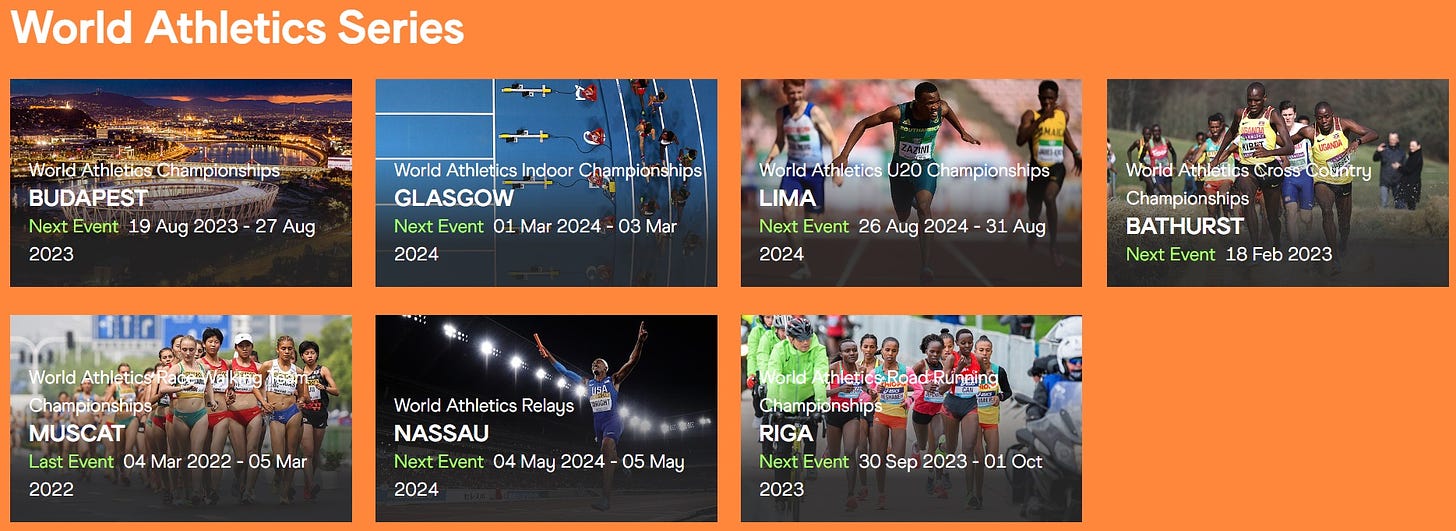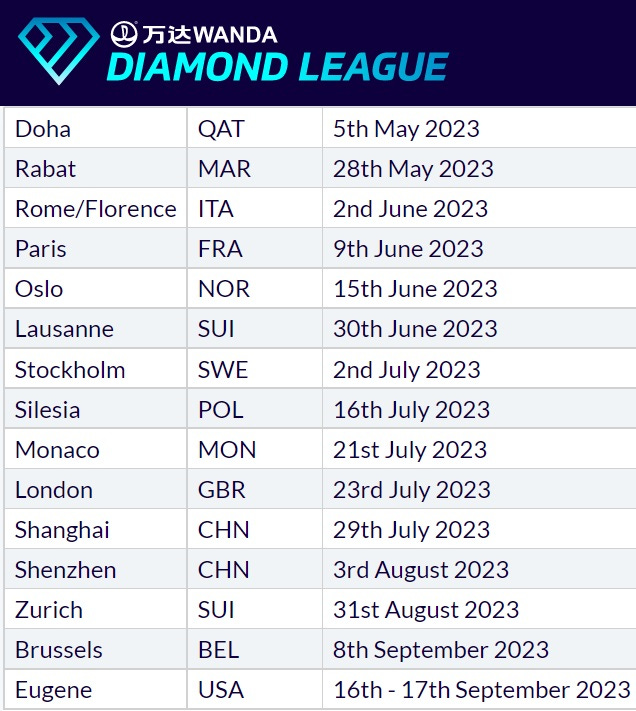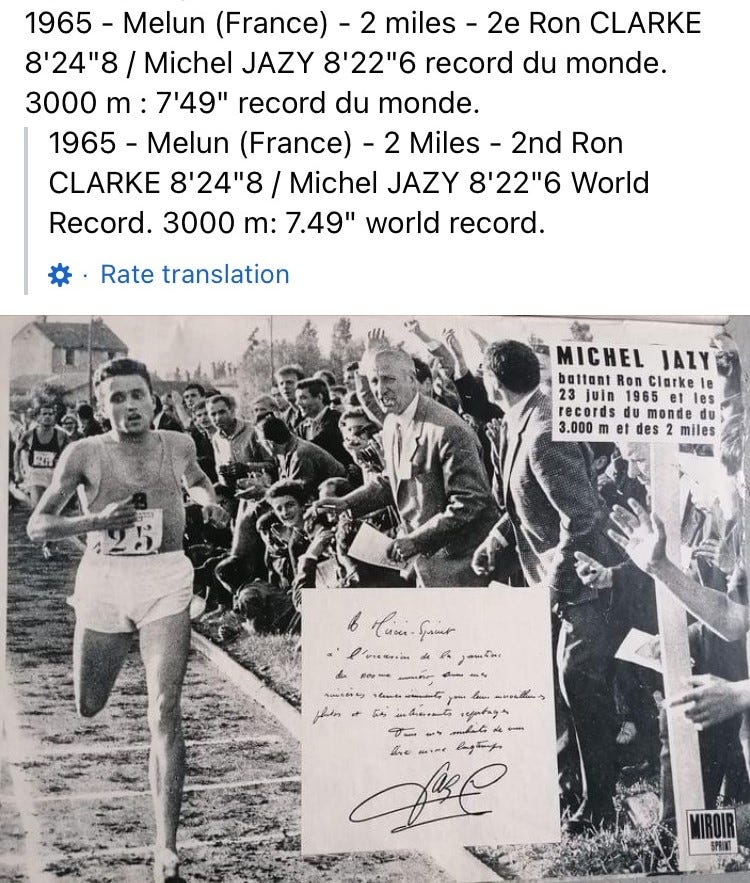Highlights of the 2023 running calendar
And an anecdote, wrapped in a tribute inside a spreadsheet
Since the early 1990s, the lords of track and field have maintained a pattern of staging outdoor world championships in odd-numbered years to complement the Summer Olympics that fall in leap years. Until the coronavirus pandemic, this resulted in a cycle of three “on” years followed by one “off” year in terms of the availability of global hardware.
The delay by one year of the 2020 Tokyo Olympics and the 2021 World Athletics Championships has resulted in 2023 being the third of five consecutive years that will feature a global track-and-field championship. This obviously creates a more concentrated revenue stream for World Athletics, the International Olympic Committee, and NBC, but it’s probably good for the competitors, too. Athletes just entering their prime, if you’re into those, will have the chance to shoot for a World Championships or an Olympic Games berth in six of the next seven summers.
Below are some of the big-deal professional-level 2023 events assured of hijacking my attention. I’m omitting road races altogether, but I will probably notice many of these as well as they occur.
But before I get to that, a shout-out to a one-of-a-kind runner I first met over 33 years ago named Eric Morse. I will introduce him through Dave Dunham’s summary of his achievements.
With the 4,111 miles he ran in 2022, Eric has run a total of 173,668 miles. He has averaged over 12 miles a day since he started running in 1981. He has missed only 62 days since November of 1983, when he started tracking his miles. He currently has not missed a day in 14 years and 9 months.
He is a member of the Mount Washington Road Race Hall of Fame, the RunVermont hall of fame, and the Harwood Union High School Hall of Fame. He was a six-time high-school state champion in track and cross-country.
Eric reached 100,000 miles on Friday, March 31, 2006 (he had just turned 41).
Eric has raced 812 times and won over half of those races. His total number of top-five finishes (by place) are:
1st – 411, 2nd – 105. 3rd – 47. 4th -41, 5th – 25
Eric’s personal records:
1500m - 3:43.9; 3000m – 8:29.5; 2M – 8:58.9; 5K – 14:20.1; 4M – 19:07; 8K – 23:41; 5M – 23:20; 10K – 29:30; 15K – 45:48; 10M – 50:49; 20K – 1:00:48; Half-marathon – 1:07:31; 30K– 1:40:18; Marathon – 2:30:08
Eric’s dog Murdock has run 29,000 miles, with only one year under 2,000 miles.
I have a number of Eric Morse (and Dave Dunham) stories from our days as Central Mass Striders teammates, when he and Dave were at the tail end of their fastest years and I was racking up personal bests far behind them. I wish I could say there was ribaldry and debauchery to report, but alas, Eric just a low-key, drama-free guy with a competitive streak.
Eric came to the University of Vermont Indoor Christmas Invitational in December 1989, my sophomore year. He would have been 25, according to the above information Dave supplied. I had never heard of him, but one of my teammates had attended the same high school as Eric and stated flatly as soon as he saw him enter the field house that this quiet-looking dude in glasses was going to wipe Gutterson Field House with everything our stacked team could throw at him.
That day, I was entered in both the 1,500 meters and the 1,000 meters, not asking or caring why. Because the last of my adventurous high-school girlfriends (at least while I was actually in high school) was up from Massachusetts for the weekend, I had drunk only three or four beers the night before, substantially less than the team average. Maybe five.
We Catamounts drank our way through everything, and our coach slept through it all when he wasn’t getting hammered himself on the road trips that forced us athletes into brief and restive bouts of sobriety for the purpose of ineffective racing. I’ve mentioned before how dismal the UVM indoor track was in those days. It was a concrete 10-lap-to-the-mile eyesore with a dirt infield and lanes that collected water, dumped inside a building with no air circulation. (Edit: It may have been 160 meters, not 176 yards; I asked the coach once, and he didn’t know, but I minored in math and our indoor races started in odd places.) I would guess that it yielded times about four percent slower than a high-end c. 2023 outdoor track—a penalty none of us high-spirited but undisciplined young tosspots could remotely afford.
The NCAA had officially condemned the facility years before my arrival, but UVM was still allowed to host meets that included only us and non-Division I teams like Plattsburgh State and Norwich Military Academy.
And open runners like Eric Morse. The runner who’d claimed that Eric was close to a four-minute miler was Shane, our top 800-meter man whom I’d face that day in the 1,000m. But Shane lied or exaggerated about almost everything, and it was impossible to tell when he was being sincere. This was problematic because he frequently dispersed unlikely claims and stories that proved to be true. He probably should have hosted a radio show for stoners with a low amusement bar and a high tolerance for lost plots.
I was one of three or four UVM entries in the 1,500 meters—maybe even five—and I expected to run about 4:15 based on my strange assignment. One of my teammates in the event, Willy, was a small and shrill senior who also talked nonstop trash, but only about himself—what he’d done when no one was watching, what he’d soon accomplish when everyone was. He was about my caliber of jogger, if that. His response to Shane’s comment about Eric’s alleged four-minute-mile creds was, “Well, I wanna see him do it. I’m gonna race him.”
When the gun went off, Eric, who’d been beside me on the line wearing a plain white T-shirt and shorts so short they were hypothetical, took off at what looked like a dead sprint. He was nothing but churning pipestem limbs and amazingly long strides for his size. And Willy, true to his promise, went right with him, with an open runner named Rich Marion (another CMS guy, at least at some point) not far behind them. I eased into 68s that felt like 65s and almost laughed as I watched Willy chase this bespectacled madman in a profligate misallocation of his dubious reserves.
I later learned that Willy hung with Eric through 800 meters in 2:04, which must have been about all he had. I was over ten seconds behind and could not see them on this paperclip debacle of a racing surface without turning my head sideways.
Willy kept this gap on me until about three laps to go and then he was just done. I ran 4:13 without much of a change in pace throughout, and when I passed Willy in the final stretch, he was moving so slowly I thought he had stopped a lap too soon and forgotten about the runners ahead of him and was jogging a mistaken victory lap. Willy routinely did weirder things than that, especially on vans.
I was third in the race despite almost being lapped. Marion had come in a distant second in 4:04. Eric had run 3:51 point something on that dilapidated excuse for a track. All by himself, having driven from his home downstate on a freezing morning simply because he wanted to race someone, he had run close to the equivalent of a four-minute mile, accounting for the literal structural oppression he faced. And he never trained specifically for the mile.
Later in the meet, working far harder, I ran 2:37 or 2:38 in the 1,000 meters and finished two steps behind Shane. Shortly afterward, we were both being held inverted over kegs of Keystone beer by other superstar varsity athletes and one salty chick from Concord, New Hampshire by way of Amherst, Massachusetts, exulting in the sounds of Depeche Mode and Def Leppard. Within weeks, someone in that room near the banks of the mighty Winooski River reportedly got laid, although there was yet no Internet to confirm this. UVM did have a good men’s hockey program in those days, and more than one highly capable skier.
In the summer of 1991, an uphill mile was staged on College Street in Burlington, Vermont. The course ran from the Lake Champlain end of College Street to the UVM green. According to Google Earth, the course I believe was used climbs about 235’, more than most of today’s goofball-caliber downhill road-mile courses drop. Eric ran it in 4:48. I don’t know if it was certified, but he was an absolute animal on hills.
I would learn over the years what is evident from Dave’s summary above: Eric loves to run, loves to race, enjoys the time he spends with his friends out there, and loves his dog (he’s had more than one Murdock, I believe). He once told me he went to his high-school track, then a 440-yard dirt layout, the day after a subpar five-mile road race. He was intent on running twenty laps at 70 seconds a lap. He missed by two seconds. That’s 23:22 alone for five miles on dirt. Not many people understand the kind of mentality that propels such whimsical aspirations.
Imagine being on a backwoods vacation in Vermont and showing up at some track built in the Ethan Allen days to sneak in a workout, and seeing some guy take off at 4:40 mile pace. You might assume from his speed alone that he’s doing quarters. Then you keep watching, and after about three laps of this, you think, okay, mile time trial? And if you keep up your spying long enough, having probably started a watch in incredulity early in the operation, you see this guy keep going for over twenty minutes.
Anyway, here’s what’s happening domestically (for U.S. readers) and worldwide this year.
Indoors
On January 20, the first truly meaningful U.S. National Cross-Country Championships since 2019 will take place in Richmond, Virginia. I say “truly meaningful” because the USATF races will serve as World Cross Country Championships qualifiers for the first time in four years. The 2023 World Cross Country Championships will be held in Bathurst, New South Wales, Australia on February 23.
The 2023 USATF Indoor National Championships will unfold in their apparently permanent home in Albuquerque from February 16 through February 18. I’m not sure if any U.S. athletes will be shooting for both indoor nationals and World Cross, but it’s doable.
The 2023 World Indoor Championships were originally given to Nanjing, China. But in in September, that idea was nixed, and the next Indoor Worlds will be in Glasgow in March 2024. I would really enjoy going to Scotland. My maternal grandmother was an Urquhart with ancient connections to a castle there, but mostly I’m intrigued by the fashion sense of the indigenous Scottish people, which is impossible to characterize.
The 2023 World Masters Indoor Championships will take place from March 26 to April 1 in Toruń, Poland, sufficiently far from the gore next door to probably remain a safe bet for a few more weeks.
Outdoors
The first of the fifteen Diamond League meets on the 2023 slate is on April 5 in Doha. I assume these will all be streamed on Peacock.
The 2023 USATF Outdoor Championships will take place in Eugene from July 6 to July 9, between the seventh and eighth of the DL meets. After the twelfth meet, the series will pause for the 2023 World Outdoor Athletics Championships in Budapest, Hungary. The championships span the ten days between August 19 and August 28 inclusive.
The 2023 DL final is also the one DL meet on American soilage this summer, and this will of course take place at Hayward Field in Eugene, Oregon.
In closing, someone sent me a great picture. In 1965, Michel Jazy of France set three individual world records, rewriting the standard in the mile (3:53.6), the 3000 meters (7:49.0), and the two-mile (8:22.6), and was also part of a world-record-setting 4 × 1500-meter relay ream that same month. The 3,000-meter time was recorded en route to Jazy’s two-mile world record.
Here, he’s shown edging out Australia’s Ron Clarke, among the biggest ballers in the history of running, to nail down the two-mile record in Melun, France, breaking the record he had set himself in Paris two years earlier by seven seconds.
Imagine these guys on a real track, with superspikes, and pacing lights, and a bloodstream laden with the benefits of multiple TUEs. Or don’t, and just appreciate the enormity of what they did with what they were given, which is the underlying and undying appeal of watching the world’s best no matter what kind of chronometric éclat this produces.
(Note: The e-mailed version of this post incorrectly stated that Glasgow would host the World Indoor Championships in 2023.)




